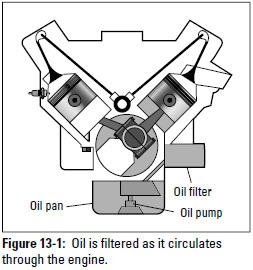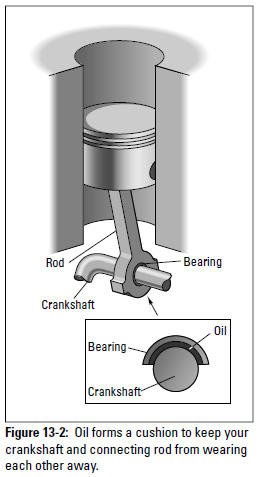To choose the proper kind of oil, you should know what that oil is expected to do. When your engine isn’t running, the oil slops around quietly in a container called the oil pan, which is located at the bottom of the crankcase just below the engine (see Figure 13-1). When the engine is running, oil is pumped by an oil pump through holes and channels in the engine, where the oil helps to cool and clean the engine and provides a nice, slippery cushion that keeps moving parts from grindingone another into oblivion.

Oil Cools the Engine
Because the oil pan is located below the engine, where the air that rushes past the moving vehicle can cool it, the oil picks up some of the heat as it travels around inside the engine and then cools off when it circulates through the oil pan. Although this isn’t enough to keep most engines sufficiently cool without a cooling system, it helps.
Oil Keeps Your Engine Clean
Most engine oils contain some detergent, which helps flush out the muck that accumulates inside your engine. Not only does detergent remove and dissolve this old sludge, but it also helps prevent new gobs of the stuff from forming. Believe me, you have no idea of the meaning of any of those yucky words until you’ve looked into the engine of a vehicle that hasn’t had its oil changed often enough. Masses of black slimy stuff, hunks of indefinable vileness, and pebble-like particles cling to everything. It’s hard to see how these engines function at all. Even more depressing are the all-too-visible signs of wear on steel parts that have been eroded away by this ugly stuff or have succumbed to friction because the oil lost its ability to protect them. If your vehicle hasn’t had its oil changed often enough, you can consider the growls coming out of its engine to be cries of pain!
Oil Cuts Down on Friction
By far the most important thing that the oil in your engine does is to form a cushion between moving parts to help them slide past one another easily.
This lubrication cuts down friction, which in turn dramatically reduces the heat and wear that friction can cause.
Figure 13-2 shows you how oil cuts down on friction. As you can see, each piston is attached to a connecting rod. Each connecting rod has a hole in it with a bearing that the crankshaft fits through, enabling the crankshaft and the connecting rod to operate together. Now take a closer look at the enlarged portion of the figure: Notice that there’s a space around the crankshaft that’s always filled with oil. When the engine is running, the oil pressure forms a cushion that keeps the connecting rod bearings from ever touching the crankshaft. Instead, each bearing moves on its cushion of oil to prevent friction and wear, which is important because the rod exerts 4,000 pounds of pressure every time it moves down. This arrangement has additional benefits: If the bearings wear, replacing them is much less costly than replacing the connecting rod or the crankshaft. This same principle applies to other moving parts in your vehicle.
Oil retards corrosion
Oil retards corrosion in your engine by enveloping the particles of water and acid that are present. These particles, plus the solid particles that the oil holds in suspension, contaminate the oil and thin it out. You must change the oil regularly to get rid of this stuff before it can build up to the point where the oil can’t do its job properly.

From Auto Repair for Dummies, copyright © 2009 by Wiley Publishing, Inc., Indianapolis, Indiana. Used by arrangement with John Wiley & Sons, Inc.










